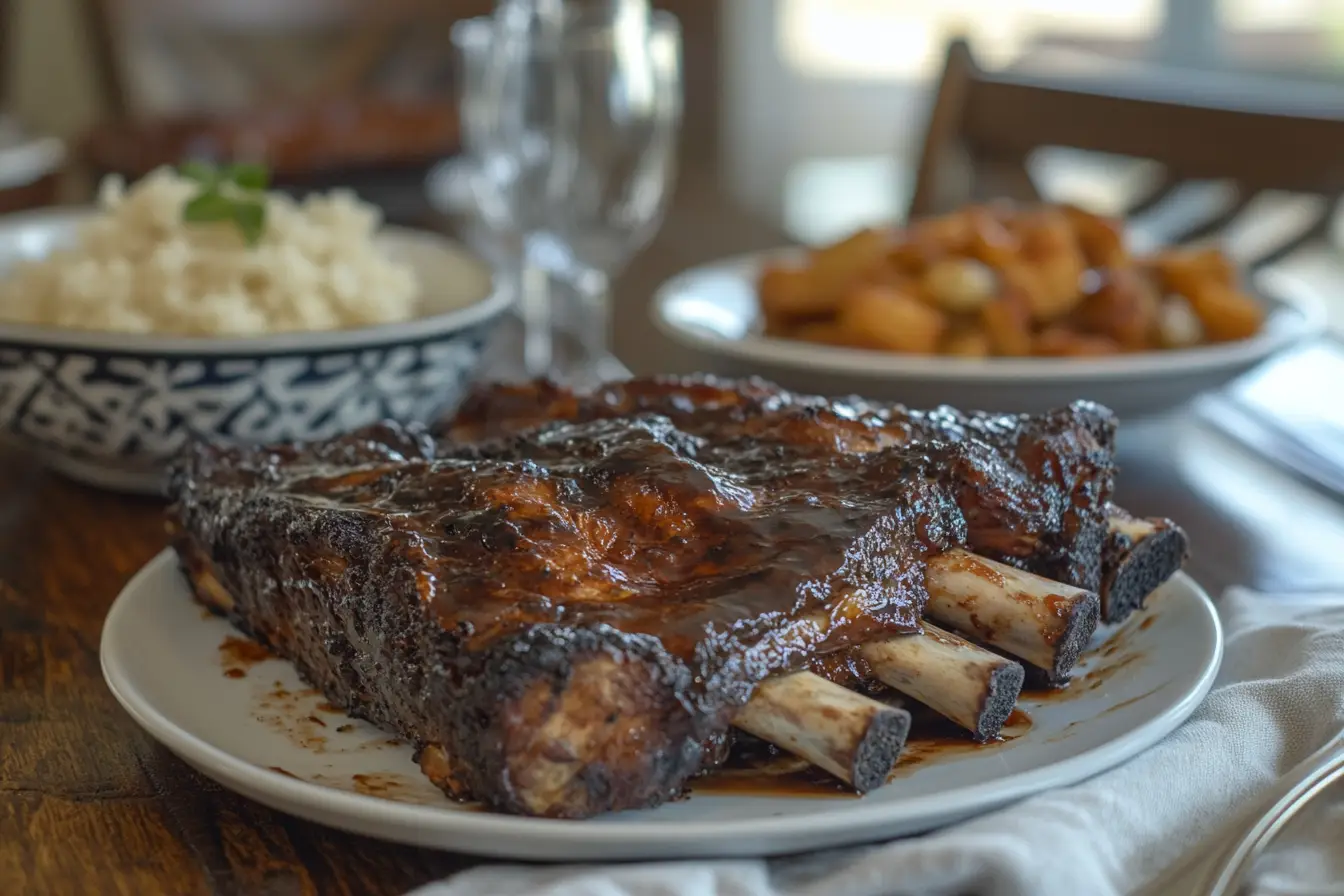When it comes to crafting tender, juicy ribs, one question often steals the spotlight: Do country style ribs get more tender the longer they cook? The answer isn’t as simple as yes or no—it depends on the cooking method, temperature, and preparation techniques. In this article, we’ll dive deep into the science of meat tenderness, explore the best ways to cook country style ribs, and uncover common mistakes that can ruin your meal. Whether you’re a seasoned pitmaster or just trying your hand at this hearty cut, you’ll walk away with tips to elevate your rib game.
Let’s start by understanding what makes country style ribs unique and how to unlock their full potential.
Understanding Country Style Ribs
What Are Country Style Ribs?
Contrary to their name, country style ribs aren’t ribs at all—or at least not in the traditional sense. Because they’re meatier and often boneless, they’re a versatile choice for hearty meals. Unlike baby back ribs or spare ribs, country style ribs boast a higher meat-to-bone ratio, making them ideal for those who crave more meat with every bite.
This unique structure also means they’re forgiving when it comes to cooking methods. Whether you braise, grill, or slow-cook them, these cuts are adaptable. However, to achieve the tender, juicy texture we all love, it’s essential to understand their composition.
Nutritional Profile of Country Style Ribs
Country style ribs aren’t just delicious—they’re also packed with nutrition. A standard serving provides a hefty dose of protein, perfect for fueling active lifestyles. While their fat content is higher than some other cuts, it plays a vital role in creating that melt-in-your-mouth tenderness when cooked properly. Plus, these ribs are rich in essential nutrients like B vitamins, zinc, and iron, which support energy, immunity, and overall health.
When prepared right, country style ribs are a satisfying choice for flavor and nutrition. Understanding these basics sets the stage for mastering the art of cooking this crowd-pleasing cut. Next, we’ll dig into the science behind their tenderness.
The Science of Meat Tenderness
Muscle Composition and Connective Tissue
To understand why some ribs melt in your mouth while others are tough, you’ve got to start with the meat’s structure. Country style ribs are made up of muscle fibers bound together by connective tissues like collagen and elastin. These tissues are naturally tough, but they can break down when exposed to the right cooking conditions.
Here’s the secret: When collagen is heated slowly, it transforms into gelatin—a process that gives the meat its rich, tender texture. On the other hand, elastin remains tough no matter how long you cook it, so choosing cuts with less visible elastin can improve the final result. The fat marbling in these ribs also plays a key role, melting as it cooks to keep the meat moist and flavorful.
Effects of Cooking on Meat Fibers
Do country style ribs get more tender the longer they cook? The short answer is yes—but only under the right circumstances. Cooking these ribs slowly at a low temperature allows the connective tissues to break down fully, resulting in a tender, juicy bite. This is why methods like slow cooking or braising are so effective.
However, rushing the process can have the opposite effect. High heat tightens muscle fibers and risks drying out the meat before the collagen has a chance to break down. The key is patience and consistency—letting the magic happen over time.
Best Cooking Methods for Tender Ribs
Low and Slow Techniques
When it comes to country style ribs, the “low and slow” method reigns supreme. Whether you’re using a slow cooker, smoker, or oven, gentle heat over several hours works wonders. Cooking ribs at a low temperature, like 275°F, for two to three hours allows collagen to break down completely, transforming the meat into a tender masterpiece.
Adding moisture is equally important. A splash of broth, apple cider, or a tangy marinade can prevent the ribs from drying out. Cover the dish tightly to trap steam, which helps maintain the meat’s tenderness. This technique is practically foolproof and delivers ribs that fall apart with every bite.

High-Heat Methods for Quick Cooking
Sometimes, you need ribs in a hurry. Grilling or broiling at high heat can still yield great results, but it requires a little finesse. Start by cooking the ribs over indirect heat to prevent charring, then finish with a quick sear to lock in the juices. A meat thermometer is essential here—aim for an internal temperature of 145°F to ensure they’re safely cooked without losing their tenderness.
While high-heat methods are faster, they’re less forgiving. If you push the heat too high or cook too long, the ribs can become dry and tough. To strike a balance, combine high heat with a marinade or sauce that helps retain moisture.
Combination Cooking for Optimal Results
For the best of both worlds, try a combination approach. One popular method is sous vide, where the ribs are cooked in a water bath at a precise, low temperature for several hours. Afterward, they’re finished on a hot grill or under the broiler for that irresistible caramelized crust. This method guarantees perfectly tender meat with a flavorful exterior.
In the end, the best cooking method depends on your time, tools, and taste. By choosing the right approach, you can control the tenderness and flavor of your country style ribs like a pro.
Factors Beyond Cooking Time
Importance of Meat Quality
Choosing the right cut of country style ribs is crucial for achieving perfect tenderness. High-quality ribs with visible marbling tend to stay moist and flavorful throughout cooking. The intramuscular fat melts as it cooks, contributing to that melt-in-your-mouth texture. Freshness also plays a significant role. Fresher cuts are naturally juicier and retain their structure better during the cooking process.
When possible, source your meat from reputable butchers or local farmers. Their products often offer superior flavor and texture compared to mass-produced cuts, setting the stage for a more enjoyable meal.
Enhancing Flavor with Marinades and Brining
Marinades and brines do more than add flavor—they help tenderize the meat. Acidic components, such as citrus juice or vinegar, break down muscle fibers, making the ribs softer. Similarly, brining infuses moisture into the meat, ensuring it remains juicy even during long cooking periods. For the best results, marinate or brine the ribs for several hours or overnight.
For more delicious recipes and techniques, explore the Pellet Grill Recipes for inspiration on smoky and tender meats.
Common Cooking Mistakes to Avoid
Cooking at Too High a Temperature
One of the most frequent missteps when cooking country style ribs is using too much heat. While it’s tempting to speed things up, high temperatures can tighten muscle fibers, making the ribs tough and dry. Instead, stick to low and slow methods for the best results. If you’re asking, Do country style ribs get more tender the longer they cook?, remember that time and temperature go hand in hand.
Skipping the Use of Liquids
Neglecting to add moisture during cooking is another common mistake. While country style ribs have enough fat to retain some moisture, a liquid like broth, apple juice, or barbecue sauce creates steam, preventing the meat from drying out. Covering the pan or slow cooker traps this moisture, yielding juicy, tender results.
Overcooking the Ribs
Even with low heat, cooking the ribs too long can lead to a mushy texture. Overcooking breaks down the meat excessively, robbing it of its structure. To avoid this, keep an eye on the cooking time and use a meat thermometer. Aim for an internal temperature of 195°F–200°F for fall-apart tenderness without losing the ribs’ integrity.
If you’re new to mastering the art of slow cooking, check out our guide to -______- for more tips and tricks.
By steering clear of these common mistakes, you’ll unlock the full potential of your country style ribs, making every bite tender and flavorful.
Frequently Asked Questions
Do Country Style Ribs Get More Tender the Longer They Cook?
Yes, country style ribs do get more tender with prolonged cooking, but it’s all about the method. Low and slow cooking at a controlled temperature allows the collagen in the ribs to break down into gelatin, creating a melt-in-your-mouth texture. However, overcooking—even at low temperatures—can make the meat lose its structure and become mushy. Balance is key when striving for the perfect tenderness.
For step-by-step guidance on achieving perfectly tender ribs, check out this guide on low and slow cooking techniques.
How Do You Get Super Tender Ribs?
Achieving super tender ribs comes down to a few essential steps:
- Cook low and slow: Use an oven, slow cooker, or smoker at around 275°F to gradually break down tough connective tissues.
- Add moisture: Incorporate liquids like broth or apple cider vinegar to maintain moisture during cooking.
- Rest the ribs: Allow them to sit for 10 minutes after cooking to let the juices redistribute.
Can You Cook Country Style Ribs Too Long?
Yes, cooking country style ribs for too long, even at a low temperature, can lead to overly soft, mushy meat. While longer cooking times are great for breaking down collagen, there’s a limit. Always monitor the internal temperature and aim for 195°F–200°F for optimal tenderness without compromising texture.
Why Are My Country Style Ribs So Tough?
If your ribs are tough, the likely culprits are high cooking temperatures or insufficient cooking time. Rushing the process at high heat causes muscle fibers to tighten, resulting in chewy meat. Additionally, skipping steps like adding liquid or covering the ribs can lead to dryness.
The Importance of Resting Meat After Cooking
Why Resting Enhances Tenderness
One often overlooked but essential step in cooking meat is allowing it to rest after it’s finished cooking. Resting gives the juices, which are forced to the center of the meat during cooking, time to redistribute evenly. This simple step ensures every bite is moist and flavorful. Skipping this step can lead to juices spilling out when the meat is sliced, leaving it dry.
For country style ribs, resting is particularly important after slow cooking or broiling. While they’re already tender from the cooking process, letting them rest for 10-15 minutes enhances their texture and flavor. This is another way to ensure the answer to Do country style ribs get more tender the longer they cook? remains a resounding yes, provided you follow all the right steps.
Tips for Proper Resting
To maximize the benefits of resting:
- Tent the ribs loosely with foil: This traps heat without steaming the exterior.
- Time appropriately: Larger cuts or racks of ribs may need a bit more resting time compared to smaller pieces.
Creative Serving Suggestions for Country Style Ribs
Pairing Ribs with Complementary Dishes
Country style ribs are versatile and pair wonderfully with a range of sides. From classic mashed potatoes to roasted vegetables or fresh coleslaw, the options are endless. For a smoky flavor, consider serving them with a side of grilled corn or baked beans.

Sauce it Up!
A well-chosen sauce can elevate your ribs to new heights. Tangy barbecue, smoky chipotle, or even a honey mustard glaze can complement the natural flavors of the ribs. Experimenting with sauces adds variety to your rib repertoire, keeping every meal exciting.
Conclusion
In answering the key question, Do country style ribs get more tender the longer they cook?, we’ve explored how time, temperature, and preparation come together to create the perfect dish. By understanding the science of meat tenderness, choosing the right cooking methods, and avoiding common mistakes, you can consistently achieve tender, flavorful results.
Whether you’re slow cooking for hours or broiling to caramelize a sticky sauce, the key is balance and patience. Don’t forget to rest your ribs and pair them with sides and sauces that complement their rich, hearty flavor. With these tips, you’re well on your way to mastering country style ribs.

